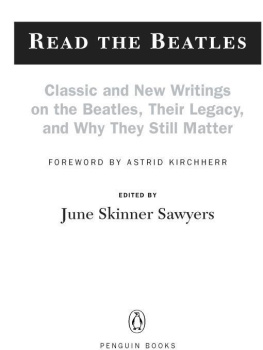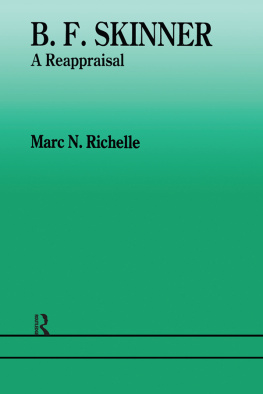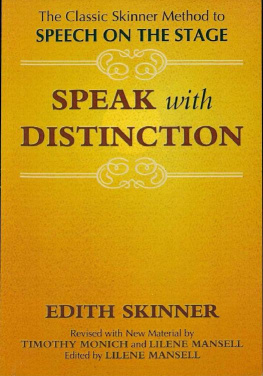B. F. Skinner - The Technology of Teaching
Here you can read online B. F. Skinner - The Technology of Teaching full text of the book (entire story) in english for free. Download pdf and epub, get meaning, cover and reviews about this ebook. year: 2016, publisher: The B. F. Skinner Foundation, genre: Religion. Description of the work, (preface) as well as reviews are available. Best literature library LitArk.com created for fans of good reading and offers a wide selection of genres:
Romance novel
Science fiction
Adventure
Detective
Science
History
Home and family
Prose
Art
Politics
Computer
Non-fiction
Religion
Business
Children
Humor
Choose a favorite category and find really read worthwhile books. Enjoy immersion in the world of imagination, feel the emotions of the characters or learn something new for yourself, make an fascinating discovery.
- Book:The Technology of Teaching
- Author:
- Publisher:The B. F. Skinner Foundation
- Genre:
- Year:2016
- Rating:3 / 5
- Favourites:Add to favourites
- Your mark:
- 60
- 1
- 2
- 3
- 4
- 5
The Technology of Teaching: summary, description and annotation
We offer to read an annotation, description, summary or preface (depends on what the author of the book "The Technology of Teaching" wrote himself). If you haven't found the necessary information about the book — write in the comments, we will try to find it.
The Technology of Teaching — read online for free the complete book (whole text) full work
Below is the text of the book, divided by pages. System saving the place of the last page read, allows you to conveniently read the book "The Technology of Teaching" online for free, without having to search again every time where you left off. Put a bookmark, and you can go to the page where you finished reading at any time.
Font size:
Interval:
Bookmark:

THE TECHNOLOGY OF TEACHING


THE TECHNOLOGY OF TEACHING

BY
B. F. SKINNER
Copyright 1968 by Meredith Corporation
Copyright 2003 by B. F. Skinner Foundation
www.bfskinner.org
All rights reserved. No part of this book may be reproduced in any form or by any means without permission in writing from the publisher.
ISBN 978-0-9964539-3-6 (mobi)
B. F. Skinner Foundation Reprint Series
Edited by Julie S. Vargas
Harvard Educational Review, 24:2 (Spring 1954), pp. 86-97. Copyright 1954 by the President and Fellows of Harvard College. All rights reserved. Reprinted with permission.
by B. F. Skinner. First appeared in Science, October 24, 1958, Vol. 128, pp. 968-977.
by B. F. Skinner. Reprinted by permission from Proceedings of the Royal Society, B, 1965, Vol. 162, pp. 427-443.
by B. F. Skinner, The Saturday Review, October 16, 1965. Reprinted with permission from General Media International, Inc.
To a teacher
Miss Mary I. Graves
(1863-1922)
Acknowledgments for this e-book version
The B. F. Skinner Foundation would like to thank the Association for Behavior Analysis International (ABAI) for the encouragement and financial support that made this electronic format possible.
ACKNOWLEDGMENTS
Four of the chapters in this book have already been published. was read before the Philosophy of Education Society in April, 1965, and published in The Saturday Review, October 16, 1965. Permission to reprint these chapters is gratefully acknowledged. Some material has been taken from two other published papers: Why We Need Teaching Machines, Harvard Educational Review, 1961, Vol. 31, pp. 377398 and Reflections on a Decade of Teaching Machines, in Teaching Machines and Programmed Learning, II, edited by Robert Glaser, Department of Audio Visual Instruction for the National Education Association, 1965, and prepublished in Teachers College Record, 1963, Vol. 65, pp. 168177.
Three chapters, not previously published, were prepared for special occasions. was given as an inaugural address at the dedication of the Psychology and Education Building at Mount Holyoke College on October 8, 1966. All chapters appear in the order in which they were published or presented. Since each was prepared as a unit, a few points appear more than once. Minor changes have been made to reduce repetition, to bring references up to date, and to add material. Four chapters have been written especially for this book.
It is a pleasure to acknowledge the help of many people. Frank Keppel, former Dean of the Harvard Graduate School of Education, offered financial and moral support from the beginning, and McGeorge Bundy, former Dean of the Graduate School of Arts and Sciences, was equally helpful. Together, they were responsible for Harvards Committee on Programmed Instruction, expertly directed by Wade Robinson and James G. Holland. Dr. Hollands collaboration, particularly in the use of teaching machines in my course on human behavior, was especially valuable. Susan Meyer Markle, Lloyd Homme, Nathan Azrin, and Matthew Israel helped on early projects. Douglas G. Porter, now in charge of Harvards Office of Programmed Instruction, has been helpful throughout. My students and my daughter, Deborah, were cheerful and courageous subjects in exploratory phases and have my thanks. Mrs. Alexandra Huebner has been an invaluable help in the preparation of the manuscript.
In addition to the personnel and space supplied by Harvard University, I am pleased to acknowledge financial support from the Ford Foundation, the Carnegie Corporation, the United States Office of Education (Grant 71-31-0370-051.3), and the Human Ecology Fund. A Career Award from the National Institutes of Mental Health (Grant K6-MH-21, 775-01) has supported preparation of about half the book.
B. F. S.
CONTENTS
FOREWORD I
This volume, Skinners only book on education, is a collection of essays, most of which had either been previously published or had served as texts for lectures over a period of twelve years. Four of the essays were written for this book. The content is wide-ranging from the etymology of teaching to teaching machines and programmed instruction, teaching thinking, ethical behavior and self-control, to classroom behavior management, and changes in the education establishment consistent with the new approach.
Though not in his original plan, Skinner addressed this book to readers well experienced in the laboratory experimental analysis of behavior and its conceptual underpinnings, both explicit and implicit. His intent was to encourage if not coax sophisticated experimental behavior analysts into research and development in the instructional domain. Unabashedly he points out the weaknesses of educations approach to, if not disregard of, the effectiveness of teaching practicesall potentially fixable by those facile with the concepts and methods of experimental behavior analysis.
The historical importance of this work is undeniable. It represented the first attempt to apply a scientifically validated conceptual methodologic system to classroom instruction. The methods of experimental analysis have been around since Claude Bernard. Skinners conceptual system is both comprehensive and timeless. The contents of this volume do not present either, yet they are basic to the usefulness of this book.
The current timeliness of this assemblage of papers must be viewed against the backdrop of the research and developments in instructional design that have occurred since Skinners seminal contributions. His methods form a fundamental component in the mosaic of successful procedures which, when combined by those fluent in experimental and conceptual behavior analysis, produces more dramatic gains than ever before documentedat all education levels.
To comprehend how Skinners system is woven into the texture of maximally effective instructional programs and how to use its riches in selecting and designing curricular procedures requires more than exposure to its parts and principles. Incorporating Skinners offerings into designs with maximal return to both instructor and student requires a depth of conceptual grasp and fluency in its application provided by very few sources.
Beatrice H. Barrett
Chatham, Massachusetts
March, 2003
FOREWORD II
For me the beginning of behavior analysis in education began when I arrived, in the fall of 1957, at a gray clapboard building, Batchelder House. Batchelder House, then in decay, had been a rambling residence just across the street from Harvards Memorial Hall where the Psychology Department, including Skinners office and laboratory, was housed. A year earlier Skinner had received a modest grant from the Ford Foundation, and to accommodate the new staff of two was assigned one medium size room in this off campus building which had dust that must have dated back to the days of the McGuffey Reader. Memories of those days in Batchelder House give me a special personal verification of humorist Francis Parkinsons claim that active, productive and innovative activities are to be found, not in new buildings which instead house moribund organizations, but in small, converted, understaffed, and unkempt buildings. In this light it seems fitting that this room in Batchelder House served as cradle for an offspring of Skinners basic science, the experimental analysis of behavior. The infant, programmed instruction and teaching machines, was to take many forms as it grew and exerted an influence on many educational practices. Moreover, the efforts at instructional design were to reveal omissions in the basic science and were to prompt new directions of research which would, in time, enrich the parent theory.
Next pageFont size:
Interval:
Bookmark:
Similar books «The Technology of Teaching»
Look at similar books to The Technology of Teaching. We have selected literature similar in name and meaning in the hope of providing readers with more options to find new, interesting, not yet read works.
Discussion, reviews of the book The Technology of Teaching and just readers' own opinions. Leave your comments, write what you think about the work, its meaning or the main characters. Specify what exactly you liked and what you didn't like, and why you think so.















